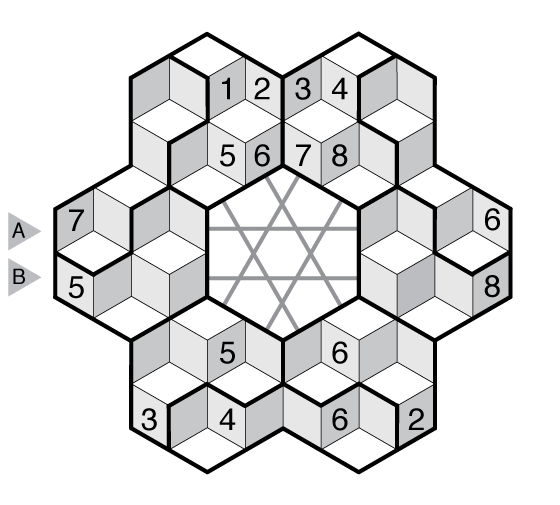Dr. Sudoku Prescribes #59 – Isodoku

or solve online (using our beta test of Penpa-Edit tools)
Theme: Last snow of winter? This Snowflake Isodoku may not be the last snowflake to fall this winter, but it will be the last snow-based puzzle from us this year.
Rules: Standard Isodoku rules, using numbers 1-8. Some rows connect across the center of the shape by following the gray lines.
Answer String: Enter the 1st “row” on the left edge, followed by a comma, followed by the 2nd “row” on the left edge.
Time Standards (highlight to view): Grandmaster = 5:00, Master = 8:15, Expert = 16:30
Solution: PDF

Nice design !
Once you wrap your head around the “rows” the actual solve is not so difficult, generally that’s my ‘problem’ with this puzzle type.
Impressive speed of releasing new puzzles !
I can’t keep up with my solving at this rate 🙂
I’m not a big fan of isosudoku, but I did enjoy the geometry on this one. The solving path felt fairly tight and relied largely on getting a feel for the geometry. I like a puzzle that sort of teaches you how to solve it on the fly.
Thanks for your comment Jack. It seems your solve followed my design goal here of teaching a bit about the geometry (like a Jigsaw Sudoku with Law of Leftovers situations) at the same time as challenging the solver with a less familiar grid. It is easy to make these puzzles very hard. It is harder to make them enjoyable.
If we are being honest here, … while it was a very intelligent design scheme, it was as convoluted as sudo-kurves, and just not all that fun to solve. It felt like work and not a pleasant diversion.
Looking forward to next week and beyond …
Yeah, I’d echo this sentiment. It’s pretty to look at, but too busy to solve on.
23:49s
Went wrong because of writing 2 same numbers in the same region (which was due to the clever tricky design which eventually led me past expert time as a result)But the solving was fun!
I think the solving path here is a bit TOO narrow for my taste. After grasping the geometry and using a trick with the shading, I placed all of the 5s, 6s, and 7s, plus a few other numbers. But I finally placed an 8 on the left side of the puzzle after looking at the puzzle several times and making notations all over it; this appears to be the breakthrough I need to finish. It’s felt more like looking for a needle in a haystack than like logical thinking.
There are some symmetric (and potentially early) spots with both 5’s and 8’s that arise from a pointing pair. Specifically, a 5 that can go in the cage where the 8 starts alone and an 8 in the cage that can go where the 5 starts alone. Both follow from the same rationale, so if you encountered that 8 towards the end, you found the big break-in.
This one was fun in theory and I really liked the aesthetic, but the issues with drawing 3D stuff started to get to me. For the first half, I was looking at it in one way (probably the standard way, i.e. the white squares are the tops of the cubes), but about half way through my vision started switching back and forth between that view and an “upside down” view (i.e. the white squares are the bottoms of cubes). It really messed with me, and probably made me take at least 3-4 minutes longer.
Several of the regions here can be seen as 3D L-shaped triominoes with a single extra “flap” on the side. I kept breaking the puzzle because I would mis-regard a digit already in that “flap” and enter a second version of that digit in the region.
The logic actually all went quite smoothly for me, (if it hadn’t been
for me messing up the geometry so often).